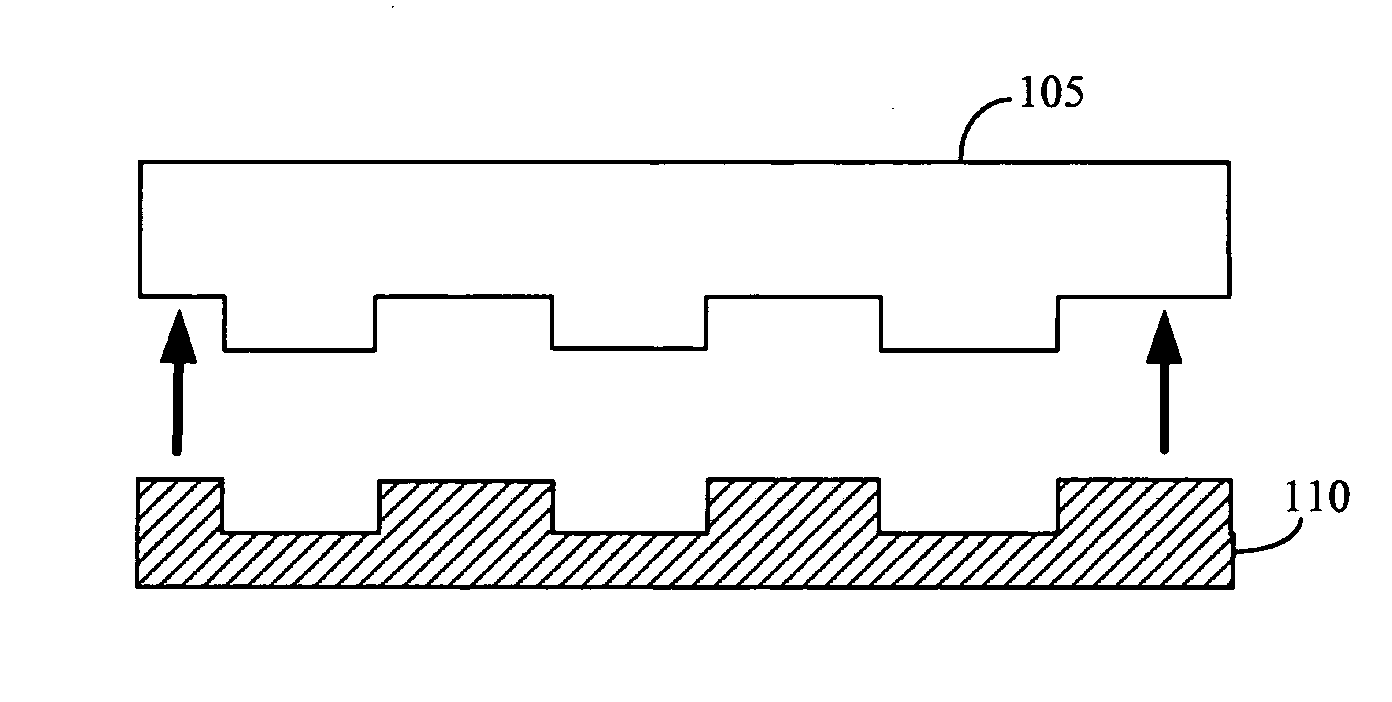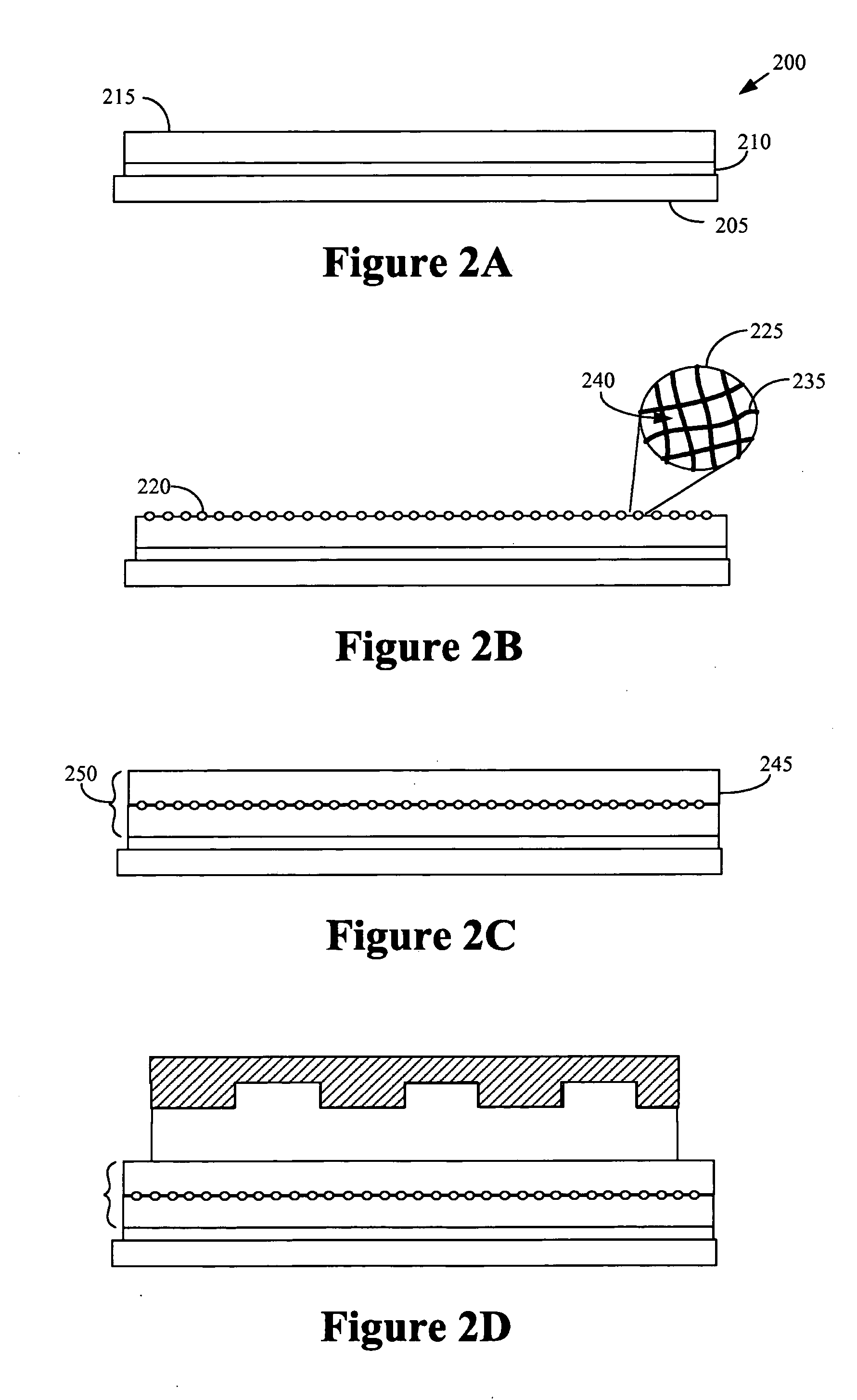Low thermal distortion silicone composite molds
a composite mold and low thermal distortion technology, applied in the field of soft lithography, can solve the problems of polydimethylsiloxane having a relatively low modulus and/or strength, collapse of features formed in molds or stamps, and the number of conventional curable materials used in soft lithography may, however, be small
- Summary
- Abstract
- Description
- Claims
- Application Information
AI Technical Summary
Benefits of technology
Problems solved by technology
Method used
Image
Examples
first embodiment
[0031] the hydrosilylation-curable silicone composition comprises (A) a silicone resin having the formula (R1R22SiO1 / 2)w(R22SiO2 / 2)x(R1SiO3 / 2)y(SiO4 / 2)z (I), wherein R1 is C1 to C10 hydrocarbyl or C1 to C10 halogen-substituted hydrocarbyl, both free of aliphatic unsaturation, R2 is R1 or alkenyl, w is from 0 to 0.8, x is from 0 to 0.6, y is from 0 to 0.99, z is from 0 to 0.35, w+x+y+z=1, y+z / (w+x+y+z) is from 0.2 to 0.99, and w+x / (w+x+y+z) is from 0.01 to 0.8, provided the silicone resin has an average of at least two silicon-bonded alkenyl groups per molecule; (B) an organosilicon compound having an average of at least two silicon-bonded hydrogen atoms per molecule in an amount sufficient to cure the silicone resin; and (C) a catalytic amount of a hydrosilylation catalyst.
[0032]Component (A) is at least one silicone resin having the formula (R1R22SiO1 / 2)w(R22SiO2 / 2)(R1SiO3 / 2)y(SiO4 / 2)z (I), wherein R1 is C1 to C10 hydrocarbyl or C1 to C10 halogen-substituted hydrocarbyl, both free ...
second embodiment
[0094] the hydrosilylation-curable silicone composition comprises (A′) a silicone resin having the formula (R1R52SiO1 / 2)w(R52SiO2 / 2)x(R5SiO3 / 2)y(SiO4 / 2)z (III), wherein R1 is C1 to C10 hydrocarbyl or C1 to C10 halogen-substituted hydrocarbyl, both free of aliphatic unsaturation, R5 is R1 or —H, w is from 0 to 0.8, x is from 0 to 0.6, y is from 0 to 0.99, z is from 0 to 0.35, w+x+y+z=1, y+z / (w+x+y+z) is from 0.2 to 0.99, and w+x / (w+x+y+z) is from 0.01 to 0.8, provided the silicone resin has an average of at least two silicon-bonded hydrogen atoms per molecule; (B′) an organosilicon compound having an average of at least two silicon-bonded alkenyl groups per molecule in an amount sufficient to cure the silicone resin; and (C) a catalytic amount of a hydrosilylation catalyst.
[0095]Component (A′) is at least one silicone resin having the formula (R1R52SiO1 / 2)w(R52SiO2 / 2)x(R5SiO3 / 2)y(SiO4 / 2)z (III), wherein R1 is C1 to C10 hydrocarbyl or C1 to C10 halogen-substituted hydrocarbyl, both fr...
third embodiment
[0116] the hydrosilylation-curable silicone composition comprises (A) a silicone resin having the formula (R1R22SiO1 / 2)w(R22SiO2 / 2)x(R1SiO3 / 2)y(SiO4 / 2)z (I); (B) an organosilicon compound having an average of at least two silicon-bonded hydrogen atoms per molecule in an amount sufficient to cure the silicone resin; (C) a catalytic amount of a hydrosilylation catalyst; and (D) a silicone rubber having a formula selected from (i) R1R22SiO(R22SiO)aSiR22R1 (IV) and (ii) R5R12SiO(R1R5SiO)bSiR12R5 (V); wherein R1 is C1 to C10 hydrocarbyl or C1 to C10 halogen-substituted hydrocarbyl, both free of aliphatic unsaturation, R2 is R1 or alkenyl, R5 is R1 or —H, subscripts a and b each have a value of from 1 to 4, w is from 0 to 0.8, x is from 0 to 0.6, y is from 0 to 0.99, z is from 0 to 0.35, w+x+y+z=1, y+z / (w+x+y+z) is from 0.2 to 0.99, and w+x / (w+x+y+z) is from 0.01 to 0.8, provided the silicone resin and the silicone rubber (D)(i) each have an average of at least two silicon-bonded alkenyl ...
PUM
| Property | Measurement | Unit |
|---|---|---|
| size | aaaaa | aaaaa |
| molar ratio | aaaaa | aaaaa |
| linear shrinkage | aaaaa | aaaaa |
Abstract
Description
Claims
Application Information
 Login to View More
Login to View More - R&D
- Intellectual Property
- Life Sciences
- Materials
- Tech Scout
- Unparalleled Data Quality
- Higher Quality Content
- 60% Fewer Hallucinations
Browse by: Latest US Patents, China's latest patents, Technical Efficacy Thesaurus, Application Domain, Technology Topic, Popular Technical Reports.
© 2025 PatSnap. All rights reserved.Legal|Privacy policy|Modern Slavery Act Transparency Statement|Sitemap|About US| Contact US: help@patsnap.com



